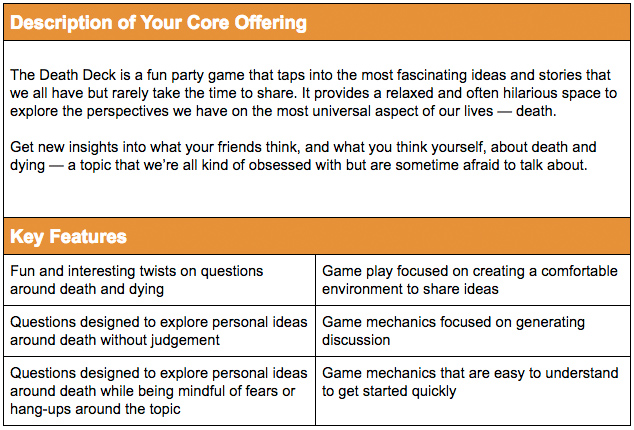
This series follows a real life startup to show how you can craft the strategy and messaging you need to launch your business idea and validate it with customers.
Quick Recap and Context
If you’re just jumping in, this series is designed to walk through a process to define the strategy and messaging for your business using the real life case study of a party game called The Death Deck. If you haven’t read that intro, it would be good to check that out first to get some context:
Read the intro to the series and the origin story of The Death Deck.
The steps being covered in this series are:
- Your Vision
- Your Target Customers’ Jobs
- Your Competition
- Your Offering and Its Features [You Are Here!]
- Your Tone of Voice and Messaging
If you’re all caught up and ready for the next step, let’s go!
Step 4: Your Offering and Its Features
This step will help you define:
- A description of your product or service targeted specifically at your customer’s Job Story
- Breaking down your offering into a set of Key Features that contribute to the experience of your customers
Why it’s important:
This step helps you look at your product or service specifically through the lens of the problem (aka. Job) you identified for your customers.
How would you describe your offering with that information in mind? How would you break apart the features of your offering in relationship to that problem? Thinking about your customer’s Job as well as the competition, are there features that now seem more important and others that don’t seem relevant to the Job at all?
From the point of view of your customer, what unique qualities of this offering most speak to their needs such that it would compel them to buy it or engage with it?

Exercise: Your Core Offering and Features
Write a description of your product or service in a way that satisfies your customer’s Job in a unique way. Then break down the individual features that make up your offering.
Here’s an example for The Death Deck that focuses on the Job of spending quality time with family and friends and highlights some points of differentiation compared to the competition.

Key Takeaways:
By looking at a product from the perspective of a customer’s Job, along with insights from the competitive landscape, you should start to see how it aligns with your customer’s needs and where you may have opportunities to differentiate in the market.
If you have features that don’t align as well with what your customer’s needs, you can deemphasize them or cut them out entirely. Deciding what you aren’t including is just as valuable as deciding what you are including.
Using this process allows you to test different ideas about your offering through inexpensive messaging edits rather than full-on product or service level changes.
Ready For More?
In the last step, we’ll take all the elements in the previous steps and translate them into the messaging you’ll use to communicate with your target customers.
Step 5 includes exercises on defining the tone of voice for your brand as well as different ways to position your message to encourage customers to engage with your offering.
Click here to get started on Step 5, Your Tone of Voice and Messaging
Need Help?
If you ever get stuck on any of these steps you can get more free resources in our Field Guide.
And if you want help from us personally, you can reach out for a free consultation any time.
If you just want free stuff to help you think about your business in new ways sent to your inbox, sign up below!


